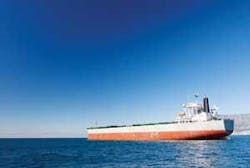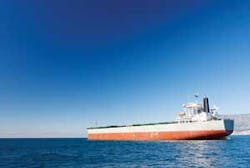Assuring the accuracy of MPA reports
John J. Mackel III, CPA Weaver and Tidwell LLP Houston
Weaver and Tidwell faced the challenge of determining how to assess the completeness and accuracy of their client’s submission report to the MPA and to create a means of enhancing that annual reporting process.
A US-based oil refiner and marketer needed to verify the completeness and accuracy of the qualified barrel submission report it provided to the Marine Preservation Association (MPA) for the reporting period that ended Dec. 31, 2006. That submission report determined the annual payment due to the MPA to assist in mitigating risks associated with potential oil spills from the transportation of client-owned oil.
Weaver and Tidwell LLP, a Texas-based regional accounting and consulting firm, was selected to conduct agreed-upon procedures, based on the firm’s overall experience in meeting the needs of oil and gas industry clients.
While the immediate objective was to assess the completeness and accuracy of the most recent submission report, the client and the MPA also gained a means for enhancing that annual reporting process, thereby promoting greater future assurance for all stakeholders.
Background
The Oil Pollution Act of 1990 (OPA 90), enacted by Congress in the aftermath of the 1989 Exxon Valdez incident, requires that companies involved in transporting, distributing, or receiving petroleum products via the nation’s waterways must establish and attain approval for safe, comprehensive contingency plans to immediately respond to an oil spill.
Oil companies vary immensely in size and financial strength, and meeting that mandate requires considerable resources. Aside from individual entity concerns, a costly duplication of services would affect the industry’s overall financial health if each company tried to fully fund and sustain such oil spill response capabilities on its own.
In founding the MPA, the oil industry established a centralized entity to support individual company compliance with OPA 90. The MPA collects annual dues from member companies. Those dues then fund operations for the Marine Spill Response Corporation (MSRC), which provides immediate response to oil spills.
MPA dues fluctuate from member to member and from year to year, based on the volume of qualified barrels of oil and other substances that each member company transports across US waterways during an annual reporting period. Qualified barrel criteria generally include:
- Barrels transported into a member’s US port or terminal across US or state waters.
- Barrels exported from a member’s US port or terminal and transported across US waters.
- Barrels produced in US or state waters.
MPA dues comprise a significant annual operating expense for its members, a cost the company bears to comply with OPA 90 and to mitigate the various risks associated with transporting its oil. Member dues also represent MPA’s sole source of funding to support MSRC efforts.
Due to those factors, it was in the client’s and the MPA’s best interests to ensure that the 2006 submission report was fair, accurate, and complete.
Challenges
Weaver and Tidwell faced numerous challenges in determining how to assess the completeness of the client’s submission report. Some of the oil the client receives and refines is owned and counted as qualified barrels by other MPA members. The client also transports product by pipeline.
In addition to identifying which oil stock and qualified barrels belonged to the client, Weaver and Tidwell also needed to evaluate the data sources and processes used for compiling the submission report. Once that evaluation was complete, Weaver and Tidwell also needed to devise a means for verifying the completeness of the client’s submission report.
Initial analysis
Weaver and Tidwell determined that terminals operated by the client or affiliates did not export any oil that could be attributed to the client as qualified barrels. Therefore, only inbound oil – oil shipped into company facilities – would be regarded as qualified barrels for the client under MPA submission report requirements.
Weaver and Tidwell’s evaluation revealed that more than 93% of the client’s inbound barrel activity occurred at its refineries. That analysis narrowed the scope for further investigation, and ensured that examination of reporting processes at those facilities would provide a representative assessment of overall client reporting completeness.
Evaluating current practices
Weaver and Tidwell learned that each business unit was responsible for reporting its own qualified barrels to a regional response manager, who then compiled the client’s submission report. Auditors then looked for a way to verify the accuracy of that report data across all business units.
Based on the conclusion that only the client’s inbound barrels counted as qualified barrels, Weaver and Tidwell concluded that totals of inventory receipts for qualified barrels received would provide a measure for determining the completeness of the company’s submission reports. Although specific practices varied slightly among the refineries, each facility followed the same general process, with inventory receipts entered into stock ledgers residing within the client’s transactional software and data warehouse systems.
As a company facing annual Sarbanes-Oxley compliance requirements, the client is required to regularly evaluate the effectiveness of controls surrounding those systems to mitigate risk of errors or fraudulent activity. Review of related Sarbanes-Oxley compliance documentation showed that the controls for inventory receipt entries, stock ledgers, and related general IT operations were functioning effectively, enabling Weaver and Tidwell auditors to place confidence in any results generated by those software and data warehouse systems.
Testing current practices for accuracy and completeness
With assurance that related controls functioned effectively, Weaver and Tidwell used data mining technology to extract inventory receipt data for the refineries from the stock ledgers residing within the transactional systems.
The inventory receipt totals were then compared to the submission report totals for qualified barrels at those facilities. A variance of 2% or less was regarded as assurance that the submission report data was complete.
Further analysis revealed that those variances were linked to minor reporting errors. One error was attributed to qualified barrels owned by another company being entered as client inventory. Some in-tank crude oil transfers were not reported correctly as excluded barrels. In another instance, refined gasoline was also not reported as excluded product. Identifying the root causes of those discrepancies enabled the client to further clarify and refine its reporting processes.
Results
Weaver and Tidwell’s performance of agreed-upon procedures verified that the client’s submission report to the MPA for qualified barrels of oil in 2006 was complete. The value of the engagement, however, extended beyond providing immediate assurance.
Through analysis, Weaver and Tidwell determined that inventory receipt totals for inbound barrel activity corresponded to the total qualified barrels listed in the client’s submission report. That provided the client with a means for evaluating and testing the completeness of qualified barrel data compiled by its various business units. Identification and analysis of minor variances between inventory stock receipts and submission report totals enabled the client to further improve its reporting processes.
With that use of inventory receipt totals for validation, the client has an ongoing means to help verify the completeness of its submission reports. The MPA can now also advise other member organizations to use that process for verifying the completeness of their submission reports, thereby enhancing the completeness of reporting practices throughout the industry and better utilize SOX documentation and testing results that may already exist.
About the author
John J. Mackel III, CPA [[email protected]], is the Houston audit partner and director of energy services for Weaver and Tidwell LLP. With offices in Houston, Dallas, and Fort Worth, Weaver and Tidwell is ranked the largest independent certified public accounting firm in the Southwest by Practical Accountant.


